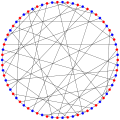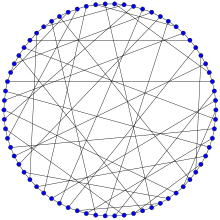Balaban 10-cage
| Balaban 10-cage | |
|---|---|
|
The Balaban 10-cage | |
| Named after | A. T. Balaban |
| Vertices | 70 |
| Edges | 105 |
| Radius | 6 |
| Diameter | 6 |
| Girth | 10 |
| Automorphisms | 80 |
| Chromatic number | 2 |
| Chromatic index | 3 |
| Properties |
Cubic Cage Hamiltonian |
In the mathematical field of graph theory, the Balaban 10-cage or Balaban (3,10)-cage is a 3-regular graph with 70 vertices and 105 edges named after A. T. Balaban.[1] Published in 1972,[2] It was the first (3,10)-cage discovered but is not unique.[3]
The complete list of (3-10)-cage and the proof of minimality was given by O'Keefe and Wong.[4] There exists 3 distinct (3-10)-cages, the other two being the Harries graph and the Harries–Wong graph.[5] Moreover, the Harries–Wong graph and Harries graph are cospectral graphs.
The Balaban 10-cage has chromatic number 2, chromatic index 3, diameter 6, girth 10 and is hamiltonian. It is also a 3-vertex-connected graph and a 3-edge-connected graph.
The characteristic polynomial of the Balaban 10-cage is
Gallery
-

The chromatic number of the Balaban 10-cage is 2.
-

The chromatic index of the Balaban 10-cage is 3.
-

Alternative drawing of the Balaban 10-cage.
See also
References
- ↑ Weisstein, Eric W. "Balaban 10-Cage". MathWorld.
- ↑ A. T. Balaban, A trivalent graph of girth ten, J. Combin. Theory Ser. B 12, 1-5. 1972.
- ↑ Pisanski, T.; Boben, M.; Marušič, D.; and Orbanić, A. "The Generalized Balaban Configurations." Preprint. 2001. .
- ↑ M. O'Keefe and P.K. Wong, A smallest graph of girth 10 and valency 3, J. Combin. Theory Ser. B 29 (1980) 91–105.
- ↑ Bondy, J. A. and Murty, U. S. R. Graph Theory with Applications. New York: North Holland, p. 237, 1976.
